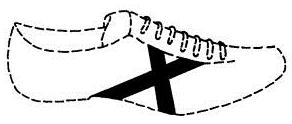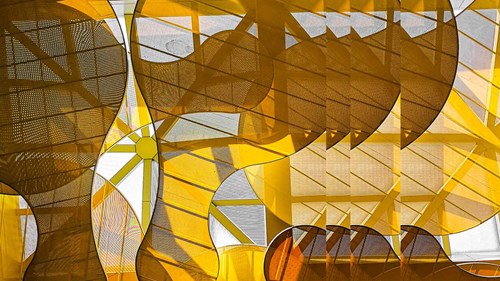Adidas loses one of its (many) "three stripe" marks
On 19 June 2019, the General Court (“EGC”) issued a judgment (Case T-307/17) with respect to the following European Union trade mark (EUTM) of adidas AG (“adidas”):

The EGC confirmed the findings of the two previous instances of the EUIPO, namely the Cancellation Division and the Second Board of Appeal, holding that the EUTM at issue has no distinctiveness, neither inherent nor acquired through use. This judgment can (and will in all likelihood) be appealed to the Court of Justice of the European Union (“CJEU”).
The conflict dates back to December 2014, when Shoe Branding Europe BVBA (“Shoe Branding”) had filed an application for declaration of invalidity against the mark in question, registered as a figurative mark for “Clothing, footwear, headgear.” in class 25 and described as follows: “The mark consists of three parallel equidistant stripes of identical width, applied on the product in any direction.”. Shoe Branding claimed that the sign was devoid of distinctive character. While adidas did not dispute that the mark is not inherently distinctive, with this action it (supported by the association Marques) attempted to show that the above “three stripe” mark had acquired distinctiveness through use.
In order to do so, adidas first alleged that the EUIPO had misinterpreted the mark and argued that the same represents a “surface pattern” which may be reproduced in different dimensions and proportions depending on the goods on which it is applied. The EGC, however, recalled that a trade mark proprietor is not entitled to a broader protection than that afforded by the graphic representation of its mark. Thus, the Court rejected adidas’ argument, stating that the mark at issue was not claimed in specific dimensions, having been registered as a figurative mark, and that it is not apparent from the graphic representation that it is composed of a series of regularly repetitive elements (i.e. a pattern).
adidas also claimed that the EUIPO had misapplied the “law of permissible variations”, according to which the use of a mark in a form differing in elements which do not alter the distinctive character of that mark as registered is also considered as use of that mark.
In this respect, first the EGC discussed the “concept of use”, reminding that the requirements regarding genuine use are analogous to those concerning acquired distinctiveness. In this sense, it is possible to take into account the use of a sign which differs from the form it was registered only in insignificant respects, so that the two signs can be regarded as broadly equivalent.
Secondly, the Court looked into the application of the “law of permissible variations” in the present case and referred to, among others, the following examples of evidence submitted by adidas:



The EGC noted that where a trade mark is extremely simple, even minor alterations to that mark may constitute significant changes, so that the amended form may not be regarded as broadly equivalent to the mark as registered. The mark at issue does not contain any word elements and presents very few characteristics, one of which is the use of three black stripes against a white background, giving rise to a specific contrast. Thus, having regard to the extreme simplicity of mark and the significance of this characteristic, the act of reversing the colour scheme, even if a sharp contrast is preserved, cannot be described as an insignificant variation as compared to the registered form. Consequently, in the Court’s view, the EUIPO’s Board of Appeal was correct to dismiss the evidence showing signs consisting of three white (or light) stripes against a black (or dark) background, two black stripes against a white background or stripes which alter in thickness and length and are cut significantly.
Finally, adidas submitted that the EUIPO’s Board of Appeal had erred in finding that it had not shown acquired distinctiveness of its mark through use.
From the (massive amount of) evidence filed, most of the documents were discarded, mainly because they relate to marks not broadly equivalent to the mark as registered or to other goods (for instance sport bags), they do not indicate the scale and duration of the use or the impact of such use on the perception of the mark by the relevant public or they do not make it possible to create a link between the figures provided and the mark or goods at issue.
As such, the Court considered only five market surveys to be of relevance. It recalled the principles regarding acquired distinctiveness established by the CJEU about a year ago in the “Kit Kat” judgment (Joined Cases C 84/17 P, C 85/17 P and C 95/17 P), according to which, although it is not necessary that evidence is submitted in respect of each individual Member State, such evidence must be capable of establishing acquisition of distinctive character through use throughout the Member States of the European Union. Against this background, the mentioned market surveys conducted in only five Member States, which cannot be extrapolated to all the Member States nor completed and supported by the other evidence, were deemed insufficient to prove acquired distinctiveness throughout the European Union.
The strict approach adopted by the EGC when assessing evidence regarding acquired distinctiveness through use reinforces the concern that the threshold (both in terms of costs and effort), especially for non-traditional marks for which the entire EU territory is relevant, might then be too high for trade mark owners (particularly smaller and mid-sized companies, as noted by Marques).
Also, this judgment does depart from the previous case-law of the EU Courts in comparable cases. For instance, in its judgment of 17 January 2018 (Case T-68/16), the EGC considered that, among others,
 constituted genuine use of the figurative EUTM
constituted genuine use of the figurative EUTM  .
.
It stated that, “although the proportions and the colour used for the cross may vary, (…) that evidence does not alter the distinctive characteristics of the mark at issue, registered in black and white, since the colour cannot be regarded as being one of the main factors giving that mark its distinctive character”. It further asserted that “the use of different colours may be taken into consideration in the present case since the contrast between the base colours and the lines constituting the cross is respected”. The mark in that case was, however, clearly a position mark, and the monopoly which had been sought significantly narrower than that sought by adidas. If confirmed by the CJEU, this case would confirm a tendency (illustrated by the “Red Bull” case – Joined Cases T-101/15 and T-102/15) of the European courts to construe very simplistic signs or those seeking excessively broad protection against their owners.

.jpg?t=a-s&arw=16&arh=9&arm=focuspoint&w=500)







